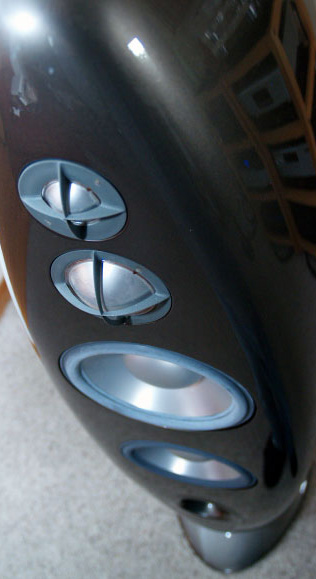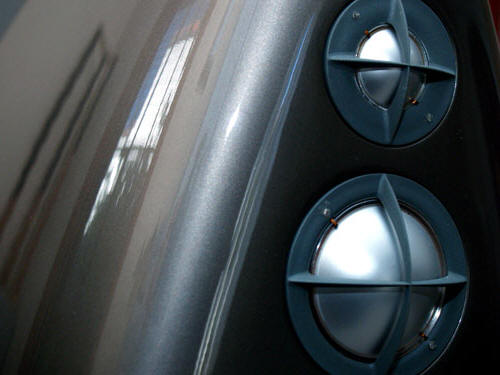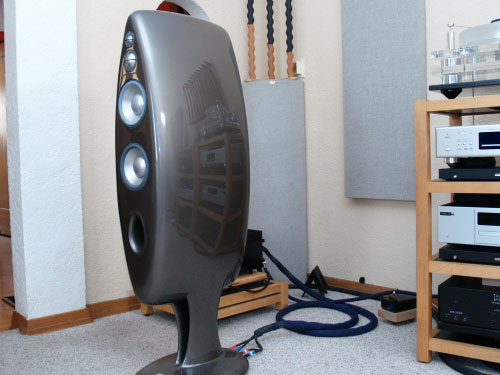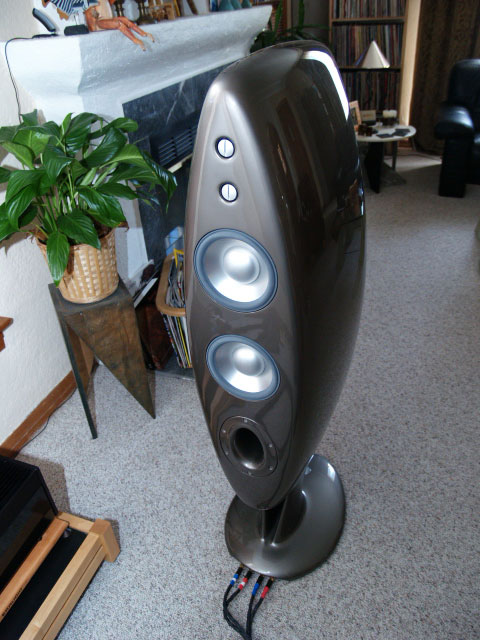You are reading the older HTML site
Positive Feedback ISSUE
january/february 2008
vivid audio
K1 loudspeakers
as reviewed by Dave Clark

|
The Vivid K1 is a rather different product from the wonderfully brilliant Laurence Dickie. Dick, as he prefers to be called, previously honed his skills at B&W where he produced the Nautilus—which is also a rather different speaker and in many ways like the Vivid K1—along with time well-spent in designing professional PA sound systems. A few years ago, Dic joined the Vivid team bringing all that he had learned in both the home and professional sides to their South African company. Here the Vivid line of loudspeakers has emerged as being …well, like I said at the beginning, rather different. In talking to Dic recently, I asked the proverbial question …the chicken or the egg? That is, what came first… how you wanted the speaker to look or how the speaker needed to look because of how you wanted it to perform? That is how did the design come about that resulted in such a different looking loudspeaker? Well, he learns that it is that way because that is the way it has to be to do what it has to do the way it needs to be done!
Meaning that first off there is the shape of the loudspeaker itself. Dic wanted to eliminate (the best he could with today's technology) the affect of the cabinet and the materials used to construct them. Hence they are not rectangular nor are they made from conventional materials (mdf and like). The Vivid line is made from a cast polymeric material with carbon fiber reinforcements. What you get is the classic form following function, but taken to the ninth degree.

And second are the drivers themselves. Not happy with off-the-shelf drivers from the key players in audio land, nor taking something and modifying it to their specifications, Dick and crew went from the ground up; again we see form following function. What we have here in the K1 (all the Vivid speaker share the same drivers only the number and configuration changes among models) are drivers made of anodized aluminum that are as pedestrian as blow-fish fin at the bottom of a cup of steaming Sake. These drivers, and how they are mounted and configured in the cabinet, are true works of art. The drivers feature tapered tube loading (the tweeters and midrange), are decoupled from the cabinet—though coupled to each other (the opposing woofers that is), are loaded into "reaction" canceling ports, have vented formers … ah shucks, go visit the Vivid website (their Technology page is a good start) to learn the whole scoop on what they are doing to push the envelope in getting a loudspeaker to not act like a typical loudspeaker. There is simply too much going on in the K1 and Vivid line for me to share here without just repeating what they already have on their site. Of course, the bottom-line is simply how does the K1 sound? I mean, you did all that but if it doesn't deliver the goods, then who really cares? It's all for naught—form follows function, but the function ain't happening. So go read the Vivid site for what they did and why it works (or I guess perhaps doesn't as someone somewhere will come up with some dissenting argument); I'll leave it up to the tech-heads to sort it all out.

What I can say is that it is obvious that Dick and the Vivid team are after the same thing that Andrew Jones of Pioneer (with the S1-EX) is after: push the envelope in loudspeaker design (for the home consumer that is) to a point that sets a new standard. Build something from the ground up using everything you know—and no doubt learn as one goes along—to make something the best one can, though no doubt at a price point for most of us. Of course the K1 is more than twice the price of the S1-EX, but then again, Pioneer is about a gazillion times larger than Vivid, so do the math. I should add that this is not going to be a "what is better, the K1 or the S1-EX?" sort of thing, though comparisons are an easy target for the reasons noted above. I will say that they do not sound alike, nor should they as Dick and Andrew have approached their designs from different perspectives (point source versus multiple drivers) along with the materials chosen for the drivers and cabinets. Not to mention differences in crossover implementations and attitudes towards parts and such.
Simply put a cabinet made from mdf will not sound like a cabinet made from a composite polymer—regardless of the shape and bracing. Different materials sound different. Ditto for the drivers: metal (in the case of the K1s, aluminum) will sound different than Aramid/carbon.
So how do the K1s sound? Very open, very clean, very fast, very pistonic, and very well-balanced. Note I say "very" a lot as that is what I heard when compared to my Reimers. The Reimers sounded more colored and perhaps "slow" when compared against the K1. But then again the Reimers are an mdf rectangular box with Morel drivers. They are very good mind you, but the Vivid are simply cut from a different piece of cloth …say the pro-end of audio in their ability to play without a hint of strain nor distortion.
Now this is what I heard—to a similar degree—with the Pioneer S1-EXs, but the K1s can play way louder and do so with a greater sense of openness. Music through the K1s simply sounded more alive and dynamic with their—super-sophisticated and engineered to the max—cabinet and driver combo really doing their thing. There is less of the speaker being in the room; the K1s sound light and fast… not heavy and dense like something made from a ton of wood. The best analogy is that of an F1 screaming down a straightaway at 230 mph as opposed to granddad's Oldsmobile rumbling around the bend.
The mids are nicely fleshed out with a great sense of evenness as well. Tonally neutral, the drivers offer nothing to jump out to grab you by the shirt collar and toss you around; unless it is on the disc. Same for the high-end, the tweeters are light and airy with a great sense of delicacy and speed. There is that speed comparison again … yeah they are clean and light. No break-up, no distortion …at least nothing that caught my attention. They play loud and the sound quality remains the same regardless—no overload nada to get in the way …scary loud!

Meaning that the K1s throw a big sound field that has little to reveal music is emanating from a pair of cabinets reflective of a contemporary art exhibit. They play big and they play wide. The cabinets really get out of the way and allow the music to unfold and fill the room.
What is truly amazing is the how the K1s can move a fair amount of air even though the bass drivers are only about 6.25"—of course there are four of these working together and with the attention to cabinet and driver design, along with the cabinet being uniquely vented …well, the bass goes very deep and is quite even. So even that the K1s on first listen sound like they go deeper with more authority than the Reimers with their four 8.75" drivers in dual-isobaric chambers. The K1s suggest a frequency response down to around 39Hz and the Reimers are purported to make it into the high teens (in my room there are very solid into the mid 20s), so what I am thinking (I have no ability to measure it so this is simply an educated guess based on experience here, in my home, with my ears, with my system) is that the K1s are able to load the room with less anomalies in the lower registers. Could be the two rear-firing woofers and how they work with the fronts in loading the room just right …of course speaker position plays a major role here as, moving them here and there will make a clearly audible change in the bass performance …quality and quantity. See, with the Reimers there is a 10dB peak at 120Hz and a 10dB suck out at 50Hz, which is audible as a degree of boom and less sense of bass "air" or bloom. With the K1 in the right position, there is simply less sense of this as the bass sounds more even and robust. Less of the 120 and more of the 50 say we? Yeah, but they still do not have the ability to go as low as the Reimers as many a deep bass disc revealed. They sound like they go lower on first listen, but one simply does not feel the bass rolling across the room, and you, as one does with the Reimers.

So what sort of colorations …or make that a character-ation are there? Well, they do use metal drivers and one would expect to hear something that screams metal. I mean, one can hear that on many other speakers that feature drivers made from that part of the periodic table, but with the K1s, well …one hears little if anything to say that they are metal. Yeah, drivers do retain to some degree the sonic quality of their construction material, but Dickie has done an excellent job of addressing this by moving the things far enough away from the driver's resonant point, that they impart almost nothing. They pretty much disappear, though naturally the cabinet plays a big role in this act as well. Yeah, I know I said almost nothing as it is impossible to make a driver out of anything sound like nothing… what it is will always leave a signature. But hats off to Dickie in making the K1s sound so un-like metal that well… if that is what you are hearing then either you are fooling yourself in thinking that, or you got Batman hearing.
These are quite wonderful speakers in that Dickie has engineered something from the future for today's audiophile …or music lover. Looking like something from the Jestons, the K1s are as revealing and honest as anything out there, and yet they do this without going over the top. They are neither colored nor washed out; they offer plenty of musical involvement with a mesmerizing sense of delicacy. The speed and coherence of the whole is quite an achievement. They sounded best bi-wired (I used a 3-meter set of Kubala-Sosna Emotions to very good effect) as opposed to single-wiring using the supplied jumpers.
Quibbles? $23k. What can I say? They ain't cheap, but a speaker built to this level of fit and finish with its design and such costs what it costs. And the looks will set them way apart from the pack. You will either find them the cat's pajamas or not …they are after all unique, but then again, form did follow function.
I would like to recognize the efforts of Josh Ray over at Sonic Flare for creating the Sonic Circle of musical attributes. I am going to take from his circle to sum up the K1s as falling in the Vivid category (no pun intended) sonically: Combining the in-your-face power of the Precise group with the warmth of the Emotional group, the Vivid category is much-loved though not entirely accepted by the American audiophile press due to the active tweaking of the frequency response. The sound is really wild and lively up top with a ton of warmth and body through the midrange and, typically, a huge bass sound that, while not flat, is fun. Precise equipment originates from the pro audio world. With flatter-than-flat measurements and super-low levels of distortion, Precise equipment manufacturers strive to reveal every last bit of detail.
Yeah, that pretty much sums up the K1s. Highly recommended. Dave Clark
K1 loudspeakers
Retail: $24,990 a pair
US Distributor:
On a Higher Note
web address:
www.onahighernote.com
TEL: 949. 488. 3004
Vivid Audio
web address:
www.vividaudio.com
